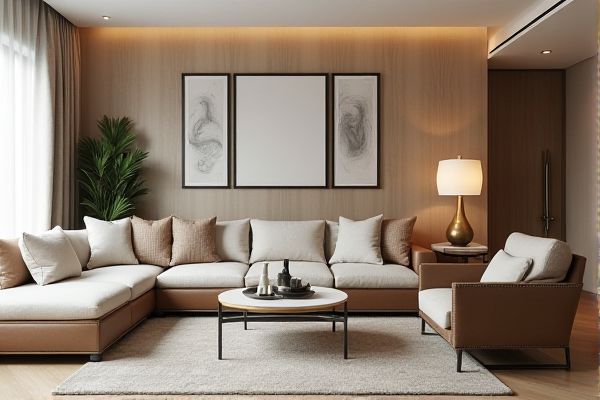
Modular furniture offers flexibility and customization by allowing you to rearrange or add components to fit changing spaces, unlike traditional furniture which is often fixed and less adaptable. Explore the rest of the article to discover which option best suits your lifestyle and interior design needs.
Table of Comparison
| Feature | Modular Furniture | Traditional Furniture |
|---|---|---|
| Design Flexibility | Highly customizable and adaptable | Fixed design, limited customization |
| Assembly | Easy to assemble and disassemble | Often pre-assembled or requires professional assembly |
| Space Efficiency | Optimizes space with compact, multifunctional units | May occupy more space, less efficient |
| Cost | Usually cost-effective and budget-friendly | Can be expensive due to materials and craftsmanship |
| Durability | Varies; often less sturdy than traditional options | Generally durable and long-lasting |
| Mobility | Easy to move and reconfigure | Bulkier, harder to relocate |
| Style Options | Modern, minimalist designs dominate | Wide range of classic and ornate styles |
Introduction to Modular and Traditional Furniture
Modular furniture offers customizable and flexible design options that adapt to changing spaces, while traditional furniture emphasizes fixed, classic styles with solid craftsmanship. Your choice depends on your need for versatility versus timeless aesthetics. Each type serves different purposes, with modular pieces excelling in dynamic environments and traditional furniture adding enduring charm.
Key Differences Between Modular and Traditional Furniture
Modular furniture offers customizable, space-saving designs with interchangeable components, ideal for dynamic living and work environments, while traditional furniture features fixed, often heavier structures crafted for aesthetic consistency and durability. Modular units emphasize flexibility and easy reconfiguration, making them suitable for small or evolving spaces, whereas traditional pieces prioritize timeless craftsmanship and solid material use, providing long-term stability. The functionality of modular furniture enhances modern lifestyle adaptability, contrasting with the classic appeal and permanence associated with traditional furniture styles.
Design Flexibility and Customization
Modular furniture offers unparalleled design flexibility and customization, allowing users to easily reconfigure components to fit varying spaces and purposes without purchasing new pieces. Unlike traditional furniture, which is typically fixed in form and function, modular systems accommodate evolving needs and personal style preferences through interchangeable modules and diverse materials. This adaptability enhances space utilization and promotes sustainable living by extending furniture lifespan through continuous modifications.
Space Utilization and Efficiency
Modular furniture maximizes space utilization by offering customizable, multi-functional designs that adapt to various room sizes and layouts, optimizing efficiency in small or irregular spaces. Traditional furniture often occupies fixed dimensions and lacks flexibility, leading to less efficient use of available space. The adaptability of modular pieces enhances organization and storage, significantly improving spatial efficiency compared to traditional furniture models.
Aesthetic Appeal and Style Options
Modular furniture offers a contemporary aesthetic appeal with customizable components that fit various modern design styles, allowing for personalized configurations and easy updates. Traditional furniture features classic craftsmanship and timeless styles that emphasize ornate details and solid wood finishes, providing a sense of heritage and permanence. Both options present distinct style opportunities, with modular pieces excelling in flexibility and traditional items often preferred for their elegance and historical charm.
Durability and Maintenance
Modular furniture typically offers enhanced durability through high-quality materials and reinforced joints designed for easy assembly and disassembly, reducing wear and tear over time. Traditional furniture, often constructed from solid wood or heavy materials, can provide long-lasting strength but may require more intensive maintenance such as polishing and repairs to address scratches or structural issues. Your choice should consider how much upkeep you're willing to commit, as modular pieces often demand less maintenance while still maintaining sturdiness.
Cost Comparison and Value
Modular furniture typically offers greater cost efficiency compared to traditional furniture due to its customizable design and ease of shipping, reducing overall expenses. Traditional furniture often has higher upfront costs and less flexibility for future adjustments, which can lead to additional expenses over time. The value of modular furniture lies in its adaptability and long-term savings, while traditional furniture is valued for its durability and classic aesthetic.
Assembly, Installation, and Portability
Modular furniture offers easy assembly with customizable components that typically require minimal tools, making it convenient for quick setup and reconfiguration. Traditional furniture often demands complex installation processes, sometimes needing professional help due to its fixed structure and heavier materials. Your choice between modular and traditional furniture will impact portability, as modular pieces are designed for effortless disassembly and transport, while traditional furniture is generally bulkier and less adaptable for frequent moves.
Environmental Impact and Sustainability
Modular furniture significantly reduces environmental impact due to its adaptability, allowing users to reconfigure or expand pieces rather than discard them, which minimizes waste. It often incorporates sustainable materials such as recycled wood, metal, and eco-friendly finishes, promoting resource conservation compared to traditional furniture made from non-renewable or less sustainable sources. The extended lifespan and efficient production methods of modular furniture contribute to lower carbon footprints and enhanced sustainability in interior design.
Which Furniture Type is Right for You?
Modular furniture offers flexibility and space-saving design, making it ideal for dynamic living spaces or frequent rearrangements. Traditional furniture provides classic styles and robust construction, suitable for those prioritizing durability and timeless aesthetics. Your choice depends on whether adaptability or enduring craftsmanship best fits your lifestyle and home environment.
 homyna.com
homyna.com